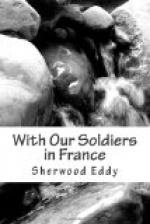Seventy years ago George Williams was the man of the hour, but a leader of the British war work of the Y M C A was found in the present crisis in the person of Mr. A. K. Yapp, General Secretary of the National Council of Great Britain, who has recently been knighted by virtue of his distinguished service for the nation. He had spent Sunday, August second, in deep searching of heart and had caught a vision of what the war would mean, and the opportunity that would be presented to an organization that was interdenominational, international, readily mobile, and adaptable enough instantly to meet a great national crisis.
Within a fortnight the British army and the whole British navy were mobilized for war. During that time the Y M C A was represented in four-fifths of the camps of the territorial forces and 250 centers were opened. In six months 500 centers were occupied; at the end of the first year there were 1,000, and after two years of the war 1,500 such centers were in full swing. The area of operations includes the British Isles, Egypt, the Dardanelles, Malta, the Mediterranean ports, India, Mesopotamia, East and South Africa, Canada, Australia, and out to the last limits of Britain’s far flung battle line.
The Y M C A has a strong homing instinct, aiming to provide “a home away from home.” In the dugouts behind the trenches, in the deserts of Egypt, or in the jungles of Africa, it has been forced to make a home in every kind of shelter. It was significant that its first three successive dwelling places seventy years ago were a little bedroom, a coffee house, and a room in a tavern. During the present war, one may see Associations in actual operation along the fighting line in France, in a cowshed, a pigsty, a stable, a hop-house, dugouts under the earth; in battered and ruined buildings in Flanders; in tents in the Sahara and on the ancient Peninsula of Mt. Sinai; at the bases of the big battle fleets; in the rest houses of the flying corps; on the Bourse in Cairo; in hotels taken over in Switzerland and France, and in the great Crystal Palace of London. In four centers it has used and transformed a brewery, a saloon, a theater, and a museum. Its dwellings stretch away from the tents of “Caesar’s Camp,” where the Roman Julius lauded in 55 B. C., on the southern shores of Britain, to the far north, in the new naval institute at Invergordon, erected for the sailors of the Grand Fleet at a cost of more than $20,000. They range from the battered dugouts at the front in France to the Shakespeare hut in London, costing more than $30,000. They stretch from the rest huts of the great metropolis, with sleeping and feeding accommodations for some ten thousand men a day during the dangerous period of leave in London, away to the hut in “Plug Street” Woods, recently blown to atoms by a shell, where the secretary escaped by a few seconds and returned to find literally nothing left save the rims of his spectacles and two coins melted and fused together by the terrific heat of the explosion. Several of the secretaries and workers have been killed by shell fire, or in transit by torpedoes from submarines, while other Association men have received the Victoria Cross for heroism in action.




